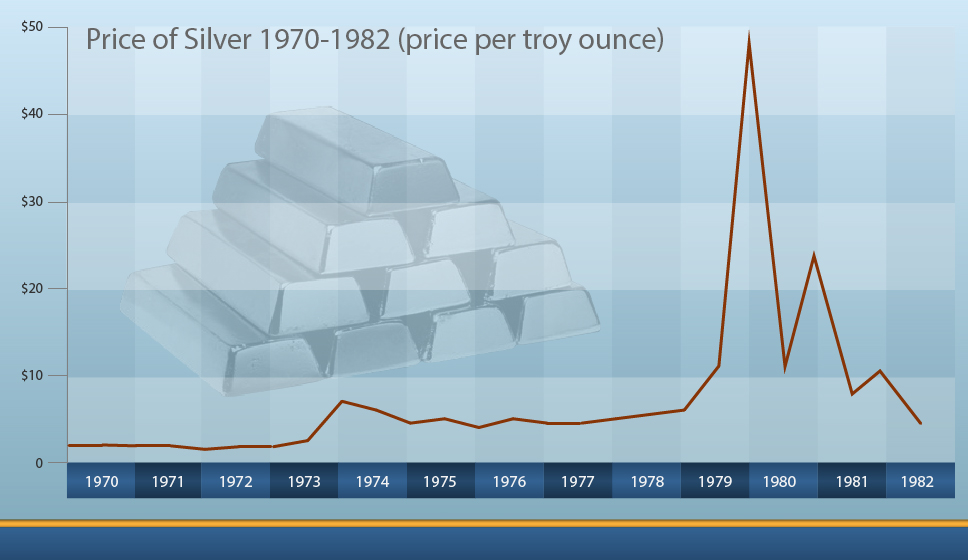 In this blog, we occasionally like to share stories of how legal graphics can change the course of litigation. The following war story comes courtesy of Roger Mead, an accomplished litigator at Folger Levin LLP in San Francisco.
In this blog, we occasionally like to share stories of how legal graphics can change the course of litigation. The following war story comes courtesy of Roger Mead, an accomplished litigator at Folger Levin LLP in San Francisco.
The story involves civil litigation against the Hunt brothers in the 1980s claiming silver price manipulation. As the accompanying graphic illustrates, silver prices spiked in 1979 and 1980 and then collapsed. In 1979, the price for silver jumped from $6 per troy ounce ($0.193/g) to a record high of $48.70 per troy ounce ($1.566/g), an increase of 712%. The billionaire brothers Nelson Bunker Hunt and William Herbert Hunt were accused of causing the spike and collapse and conspiring to manipulate the silver market. After six months of testimony in a trial in federal district court in New York before Judge Lasker, a jury found for plaintiffs (see Hunts Are Ruled Part Of A Scheme To Control Silver, NY Times, Aug. 21, 1988).
For the trial, plaintiffs had created a graphic showing the rise and fall of silver prices, and they mounted it on a long board. Judge Lasker gave the plaintiffs permission to hang the board from the ceiling of the courtroom across from the jury box. The board hung there for the entire trial.
Using the data, we created a graphic to illustrate how a blow-up chart might be designed today for this case. Whereas in the early 1980s they may have spent a great deal of time creating a hand-drawn diagram, we used Adobe Illustrator to produce this easily:
To make the timeline chart even more effective with today’s technology, we created another interactive version of it in Flash, which would allow the attorney to display the data incrementally, year by year, rather than showing it all at once.
Roger believes the silver price graph hanging in the courtroom played a large role in convincing the jury to rule for plaintiffs. As Roger says, “a plaintiff needs to prove two things: that something happened, and that defendant caused it.” That graphic of the silver price spike was a daily reminder for the jury that something had happened—a major part of plaintiff’s burden.
Some take-aways for litigators from this story:
- Identify the visual images that will help you prove your case, and get them in front of the judge and jury.
- Images mounted on boards can be effective tools, particularly if the jury can see the boards multiple times during the trial—the boards can be great reminders for the jury of earlier portions of the trial.
- As a litigator, look around the courtroom, and think about what the jury is seeing. Do not acquiesce in allowing your opponent’s visuals to remain in front of the jury longer than necessary.
If you have war stories to share with us that we might feature in a future blog post, please let us know.
If you’d like to receive updates from this blog, please click to subscribe by email.


